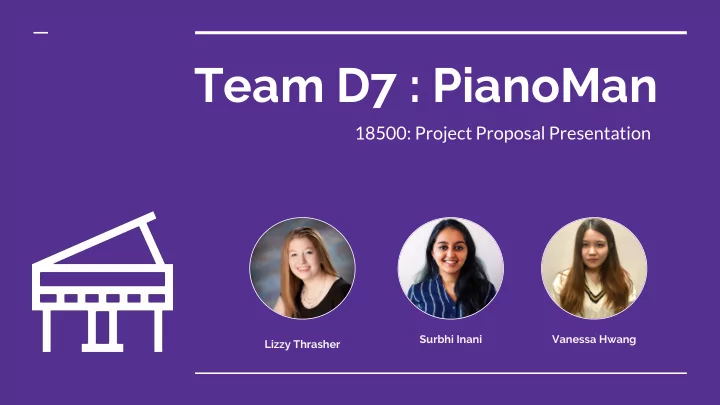

Team D7 : PianoMan 18500: Project Proposal Presentation Surbhi Inani Vanessa Hwang Lizzy Thrasher
Introduction A self-learning tool for Piano players. Reads sheet music of song, then lights up LED system using a teaching module for that song.
Problem Area : How to make Piano ● learning more fun and cost efficient ? Use Cases Allows users to scan sheet music of a song ● and learn to play that song by watching the LEDs Will combine Signal Processing (pattern ● recognition for OMR), Computer Systems and Hardware systems
Requirements and Challenges OMR (Optical Music Recognition) ● Requires an ideal scan of a sheet music to convert it to a data structure ○ Little noise, PDF, edges of image are edges of paper, horizontal lines are horizontal, one treble, ■ one bass clef alternating Use OpenCV in Python ○ Convert music data captured to MusicXML ○ Sheet music data structure in the microcontroller ● Output form of OMR -MusicXML sent through wifi ○ Note class - Keys pressed and Time duration/delay ○
Requirements and Challenges Raspberry Pi and Arduinos (Microcontrollers) ● Power requirements: +5.1V micro USB supply for Raspberry Pi 3 ○ Wifi configuration setup ○ LEDs system ● Piano white keys are 23.5 mm wide and black keys are 13.7 mm wide. LEDs circuit must be customized ○ to fit these requirements. Each LED coded to one key in the piano. The teaching module should be designed such that each key press is preceded by the LED light indicator ○ in some useful way Teaching Module ● Output from keyboard/MIDI (user input) ○ Should be able to check if the user played the sheet music correctly or not ○ Give feedback to users ○
Solution Pipeline
Solution Approach - OMR Side OMR ● OpenCV - Python for finding the characters on the sheet music ○ Going to take an ideal scan of sheet music (horizontal lines, little to no noise, binary) ○ Determine pitch and duration of each note ○ Put this data into a MusicXML file (becoming a standard in the music world). ○ References: https://repositorio.inesctec.pt/bitstream/123456789/3303/1/PS-07649.pdf
Solution Approach - Hardware Side Receive parsed MusicXML file data ● Convert to data for LEDs ● Position and duration ○ Use MIDI to check for user correctness ●
Testing, Verification & Metrics 1. Optical Music Recognition (OMR) Data: Ideal scans of sheet music from MuseScore (https://musescore.com) Test: 1. (a) Use SoundSlice (https://www.soundslice.com) to convert OMR’s output MusicXML file to PDF (b) Use Notation Software (https://www.notation.com) to play OMR’s output MIDI file 2. Check the difference between original PDF and converted PDF/played MIDI file 2. Raspberry Pi/Arduino - LEDs Data: MusicXML/MIDI files from MuseScore (https://musescore.com) Test: 1. Test if the microcontroller can successfully transfer data to LEDs 2. LEDs light up correctly according to the design requirements 3. User testing Data: Classmates Test: 1. Let them learn basic songs from MuseScore and collect feedback
Tasks and Division of Labor Lizzy Optical Music Recognition Surbhi Vanessa Hardware system Transition of data setup
Schedule - First Half
Schedule - Second Half
Recommend
More recommend